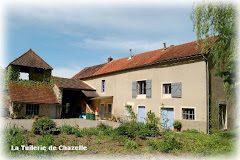 |
| L'Abergement-de-Cuisery |
I have kept myself busy for quite some time now composing an interactive map of (amongst others) Saône-et-Loire, which enables the user to easily spot where exactly to find Romanesque churches. Basis for this job was the inventory of Romanesque churches in Burgundy to be found on "
Le site sur l'Art Roman en Bourgogne".
That sounds simpler then it is in reality.
Firstly one starts off with a place name and preferably a postal code.
Those two pieces of information will locate at least the village or the town quite accurately in Google maps or in Geoportail, the French equivalent of Google Earth.
 |
| Chapaize |
For villages one has to start looking for a church on the satellite map. A church is often recognisable (but not always!) from its cross shaped plan, from the fact that a church is often (more or less) orientated along a west-east axis, and from the often semicircular chevet which closes off the body of the church on the east side. If the map gives street names, a street name contaning the word "église" is a give-away as well. An excellent example of such a church is the one in
L'Abergement-de-Cuisery.
Another give-away is that lots of churches are located on or next to a graveyard, like the
church in Chapaize.
 |
| Cathédrale - Autun |
That not all churches are to be found so easily can be seen from the aerial picture of
Autun Cathedral. The orientation is more north-south than west-east, it does not show a clear cross shaped plan and the semicircular chevet can hardly be recognised on the picture. Fortunately Google maps locates the church for you when you enter "Autun Cathedral" in the search window.
 |
| Trivy |
Another interesting example is the
church in Trivy. This church is easily recognisable as a church, however, it is even more clearly north-south orientated than Autun Cathedral. The eastern arm of the cross has a semicircular ending. This church was once a "normal" church, and orientated west-east. The present semicircular chapel was once the chevet of the church; when the church became too small the nave was demolished, and a new nave was built in north-south direction because there was more space available than in the "correct" direction. the old chevet hence became a side chapel.
 |
| Chapelle Saint-Nicolas - Autun |
A chapel is often even more difficult to find. It is quite often rectangular, hence not having a semicircular chevet, and the orientation is sometimes random. This is clearly the case with the
Chapelle Saint-Nicolas in Autun. Again, searching in Google maps for a street name or for "Chapelle Saint-Nicolas", or asking somebody who has sufficient knowledge or literature will solve this problem.
 |
| IGN zoom level 1 - Chazelle |
Ordinary road maps can also be of help. The Michelin road maps and the IGN walking maps indicate churches quite accurately, showing the researcher at least on which side of a road or of a village one can find the church. The aforementioned site Geopotail.fr offers even better options. When starting up this site it offers a satellite map; however, in the lefthand menu it offers a variety of maps to choose from. The first option is the IGN map. To illustrate the use of Geoportail I have chosen to look for the
church of Chazelle, because I can find this church in real life with my eyes closed.
 |
| IGN zoom level 2 - Chazelle |
When I enter "71460 Chazelle, Cormatin" in the search window, I end up at zoom level 1. the picture shows roughly where the church can be found in relation to the main roads.
Zooming in further, I end up on the ordinary IGN walking map.
This zoom level 2 shows more accurately where the church is, although at this scale one can only pinpoint the church quickly when one knows from zoom level 1 where to look.
 |
| IGN zoom level 3 - Chazelle |
Zooming in even further to level 3 shows the church very clearly, when one knows that grave yards are coloured violet, and churches are coloured purple. Once this far, Chazelle church can easily be traced on the satellite picture as well.
 |
| Satellite picture - Chazelle |
Most of the above I have found out by trial and error. Certainly when I started off with these maps like
the one of Saône-et-Loire I had to ask Eduard van Boxtel, the webmaster of "
Le site sur l'Art Roman in Bourgogne" many a question concerning the location of certain churches.
But, at the end of the day both of us can say that together we have cracked the system!
Chazelle church can also be found easily by asking for it at the owners of
La Tuilerie de Chazelle.















